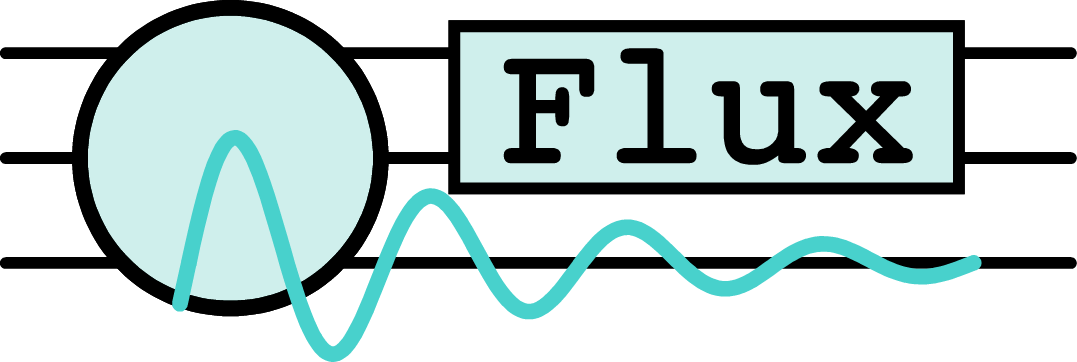Welcome to the QFlux Documentation

This is a Python package containing various protocols for performing quantum dynamics simulations with quantum devices. Each submodule contains object-oriented implementations for these protocols as demonstrated in our publication, as well as comprehensive tutorial notebooks designed to help users understand, implement and build upon various simulation techniques for studying quantum dynamics using quantum computer frameworks. Each tutorial is provided as a Jupyter Notebook in Python to offer detailed explanations in both markdown and code comments.
Installation
To get started with qflux, we recommend that you set-up a virtual environment with Python 3.10+. For example, you could create a conda environment:
Once this is completed, qflux can be installed with pip:
This will install all necessary dependencies and you are now ready to get started!
Getting Started
You can learn how to use qflux through the tutorial-format examples on this documentation website:
-
Closed Systems
-
Open Systems
-
Variational Methods
-
Generalized Quantum Master Equation (GQME)
You can also open interactive notebooks in Google Colab:
Questions, Issues, and Feature Requests
This package and its accompanying documentation are part of an actively maintained research software project. If you encounter unexpected behavior, identify a reproducible bug, or have questions not addressed in the documentation, please open a new issue using the issue template. We also welcome suggestions for new features or improvements that could enhance the functionality, usability, or scientific scope of the codebase.
Development Setup
If you're interested in contributing to qflux, you should checkout the source code and our Contribution Guide. If you are unsure where to start, consider browsing the list of open issues or proposed enhancements to identify areas where your expertise could be most impactful.
Development Installation
The first step to prepare your development environment is to clone the GitHub repo using your preferred method (web/command line interface). For additional information on how to clone a GitHub repo, you can checkout the GitHub Docs Page.
Once you've cloned the GitHub repo, you should go to that directory and begin setting up your development environment with the following commands:
This project uses uv for fast and reliable Python package management. To set up your development environment:
# Create and activate a virtual environment
uv venv
source .venv/bin/activate
# Install the package and all development dependencies
uv pip install -e ".[dev]"
# Initiate pre-commit checks
pre-commit install
uv sync
This will install all necessary dependencies, including development tools like pre-commit hooks, testing frameworks, and documentation generators.
Documentation
This project uses MkDocs with the Material theme for documentation. To work with the documentation locally:
- Make sure you have all development dependencies installed
- Run the documentation server:
- Open your browser and navigate to
http://127.0.0.1:8000
The documentation will automatically reload when you make changes to the markdown files.
Code Quality Tools
We use pre-commit hooks to ensure code quality and consistency. The following tools are configured in .pre-commit-config.yaml:
- Ruff: A fast Python linter and formatter
- Runs linting checks with auto-fix capability
- Handles code formatting
After installing the development dependencies (as described in the Installation section), enable the pre-commit hooks by running:
Now the hooks will run automatically on every commit, ensuring code quality and consistency.
Managing Dependencies
This project uses uv for fast and reliable dependency management. Here's how to manage your dependencies:
Adding New Dependencies
To add a new package dependency:
This will:
- Install the package in your virtual environment
- Update your
pyproject.tomlwith the new dependency - Update the
uv.lockfile with exact versions
Synchronizing Dependencies
If you pull changes that include new dependencies or switch branches, synchronize your environment:
This ensures your virtual environment exactly matches the dependencies specified in the lock file, removing any packages you don't need and installing any that are missing.
Writing Documentation
This project follows a structured approach to documentation. Each module should have its own markdown file in the docs/flux/ directory, organized by topic. Documentation files might include:
- Overview: A brief description of the module's purpose and key features
- Concepts: Explanation of important concepts and design decisions
- Examples: Code examples showing common usage patterns
- Source Code: Auto-generated documentation from source code annotations
Citing QFlux
Please cite the preprint of our work when using this code until the journal version becomes available. (We will add pre-formatted citation here once the pre-print goes live.)
Acknowledgement of Funding
We acknowledge the financial support of the National Science Foundation under award number 2124511, CCI Phase I: NSF Center for Quantum Dynamics on Modular Quantum Devices (CQD-MQD).